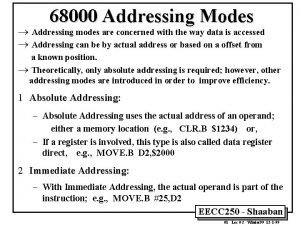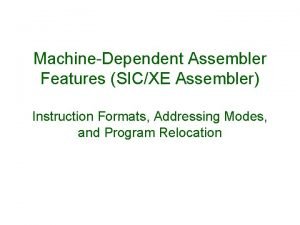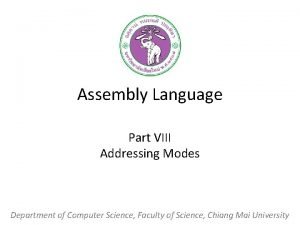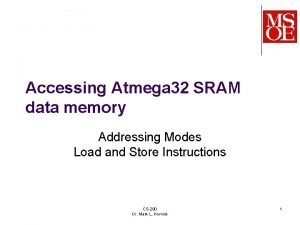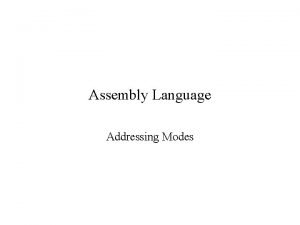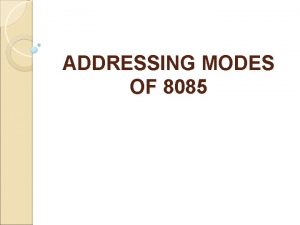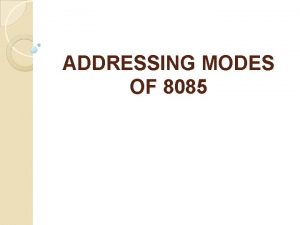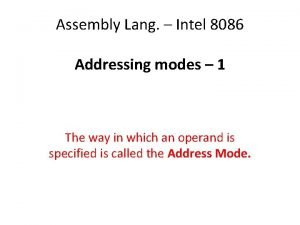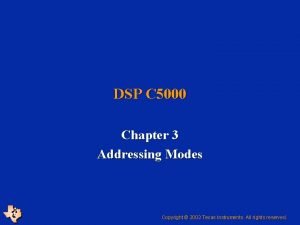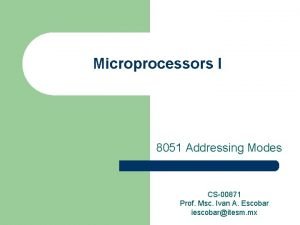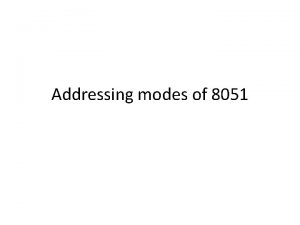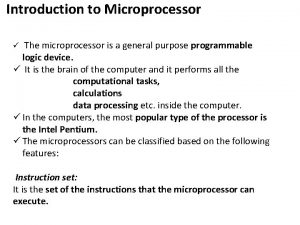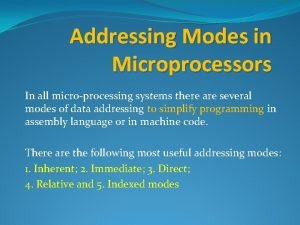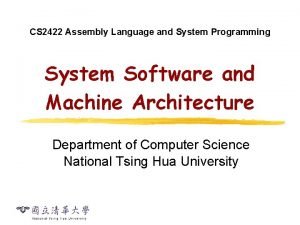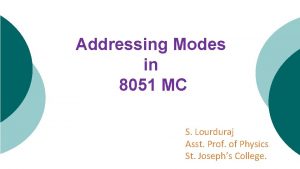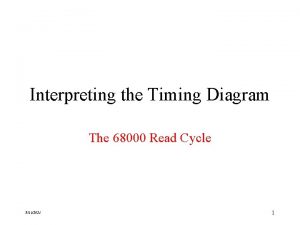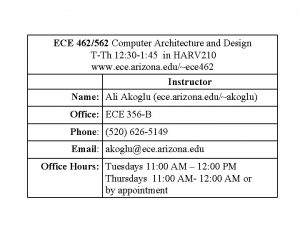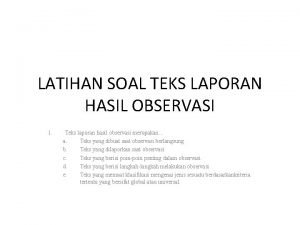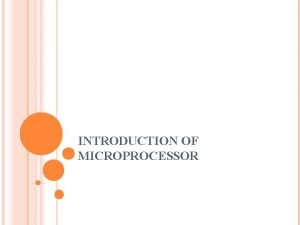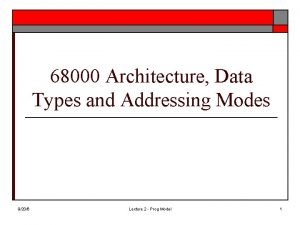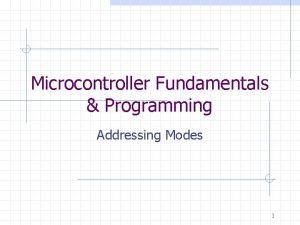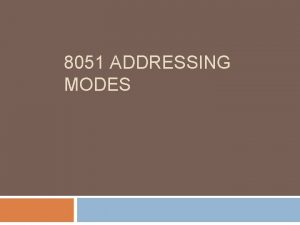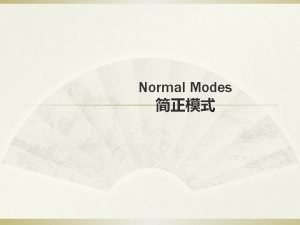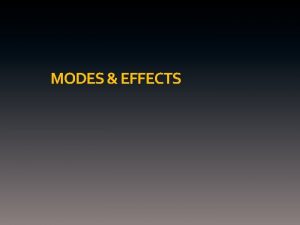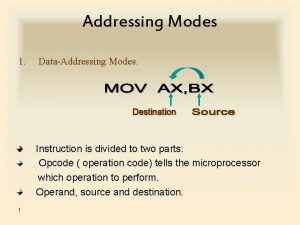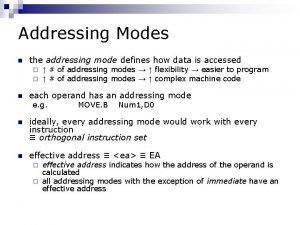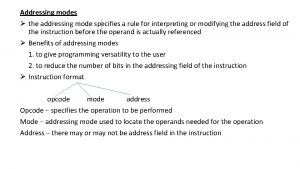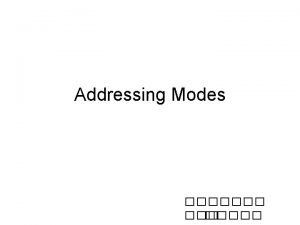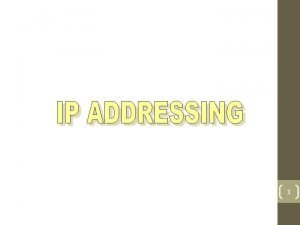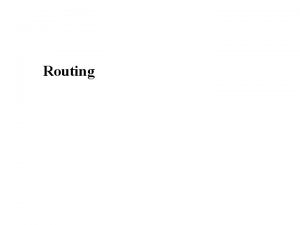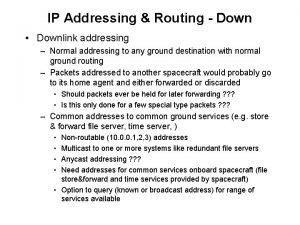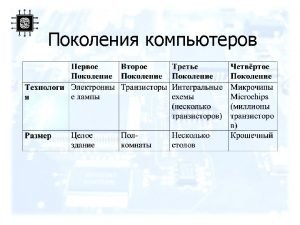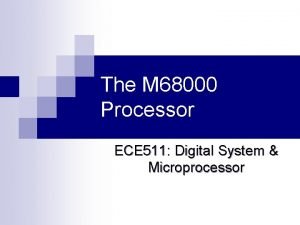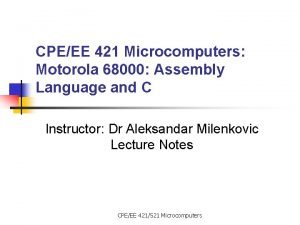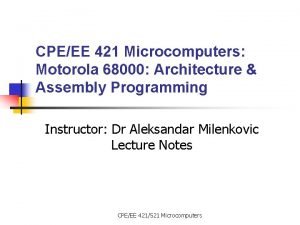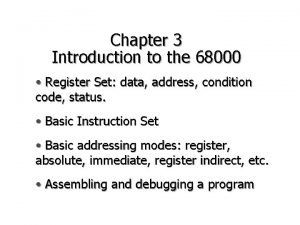II 1 68000 Addressing Modes Addressing modes are

























- Slides: 25

II. 1 68000 Addressing Modes ® Addressing modes are concerned about the way that data is accessed ® Addressing can be by actual address or based on a offset from a known position. ® Theoretically, only absolute addressing is required; however, other addressing modes are introduced in order to improve efficiency. 1 Absolute Addressing: – Absolute Addressing uses the actual address of an operand; either a memory location (e. g. , CLR. B $1234) or, – If a register is involved, this type is also called data register direct, e. g. , MOVE. B D 2, $2000 2 Immediate Addressing: – With Immediate Addressing, the actual operand is part of the instruction; e. g. , MOVE. B #25, D 2 EECC 250 - Shaaban

68000 Addressing Modes II. 2 3 Address Register Indirect Addressing: – This addressing mode uses the 8 address registers. – These registers are assumed to contain the address of the data rather than the data itself. e. g. CLR. B (A 0) 4 Address Register Indirect with Post-incrementing: – A variation of address register indirect in which the operand address is incremented after the operation is performed. The syntax is (Ai)+ 5 Address Register Indirect with Pre-decrementing: – a variation of address register indirect in which the operand is decremented before the operation is performed. The syntax is -(Ai) EECC 250 - Shaaban

Address Register Indirect with Post-incrementing / Pre-decrementing Examples II. 3 MOVE. B (A 0)+, D 3 Byte data addressed by A 0 are copied to D 3. Then the contents of A 0 are incremented by 1. MOVE. W (A 0)+, D 3 The word data addressed by A 0 are copied to D 3. Then the contents of A 0 are incremented by 2. MOVE. L (A 0)+, D 3 The long word data addressed by A 0 are copied to D 3. Then the contents of A 0 are incremented by 4. MOVE. B -(A 0), D 3 The address stored in A 0 is first decremented by 1. Then the data addressed are copied to D 3. MOVE. W -(A 0), D 3 The address stored in A 0 is first decremented by 2. Then the data addressed are copied to D 3. MOVE. L -(A 0), D 3 The address stored in A 0 is first decremented by 4. Then the data addressed are copied to D 3. EECC 250 - Shaaban

Data Movement Instructions • • • II. 4 A total of 13 instructions in all: MOVE, MOVEA, MOVE to CCR, MOVE to SR, MOVE from SR, MOVE USP, MOVEM, MOVEQ, MOVEP, LEA, PEA, EXG, SWAP MOVE copies data from one location to another and may be qualified by ". B" to move 8 bits; ". W" to move 16 bits; and ". L" to move 32 bits. MOVE does not change the source location only the destination location. MOVE updates the CCR: • N Set (=1) if the result (destination) is negative, cleared (=0) otherwise. • Z Set if the result is zero, cleared otherwise. • V Always cleared. • C Always cleared. • X Not affected. Examples: MOVE. B D 1, D 2 MOVE. B D 1, 1234 MOVE. B 1234, D 1 MOVE. B 1234, 2000 MOVE. B #4, D 0 MOVE. B #4, 1234 Register to register Register to memory Memory to register Memory to memory Literal to register Literal to memory EECC 250 - Shaaban

II. 5 EECC 250 - Shaaban

Data Movement Instructions II. 6 MOVEA Copies a source operand to an address register. May use only ". W” and ". L". In the case of ". W", the source operand is sign extended. No effect on CCR – Source Operand: All addressing modes. – Destination Operand: Address register direct. Move to CCR Copies the lower order byte of the operand to the CCR register. – Source Operand: All except address register direct. – Destination Operand: CCR register. EXG Exchanges the entire 32 -bit contents of two registers. Frequently used to copy an address register to a data register for processing. No effect on CCR. – Source Operand: Address or data register. – Destination Operand: Address or data register. EECC 250 - Shaaban

II. 7 EECC 250 - Shaaban

SWAP Data Movement Instructions II. 8 Exchanges the upper and lower order words of a data register. – Source Operand: Data register – Destination Operand: N/A – CCR set according to resulting register value. LEA Copies an effective address into an address register. – Source Operand: All except data register, address register direct, address register indirect with pre-decrement or post-increment or immediate. – Destination Operand: Address register – No effect on CCR. EECC 250 - Shaaban

II. 9 EECC 250 - Shaaban

Load Effective Address, LEA Examples Instruction II. 10 Action LEA $0010 FFFF, A 5 Loads the absolute address LEA (A 0), A 5 Loads the contents of another address register LEA (12, A 0), A 5 Loads the contents of an address register plus a displacement. LEA (12, A 0, D 4. L), A 5 Loads the contents of an address register plus a data register plus a displacement (used for index addressing). EECC 250 - Shaaban

Compare Instructions II. 11 • All compare instructions subtract the contents of one register (or memory location) from the contents of another register (or memory location) in order to set the CCR (except the X-bit). The results of the subtraction are discarded. • The compare instructions include the following: CMP Source operand: Any of the addressing modes Destination: Must be a data register. CMPA Source operand: Any of the addressing modes Destination: Must be an address register. CMPI Source operand is an immediate value Destination: Any of the addressing modes except address register direct or immediate. CMPM Compares one memory location with another Only addressing mode permitted is address register indirect with auto- incrementing. EECC 250 - Shaaban

Compare Instructions CMP <source>, <destination> • • II. 12 The compare instruction, CMP <source>, <destination>, subtracts the source operand from the destination operand updates the bits of the condition code register (CCR), accordingly. The result of the subtraction are discarded. CMP or other compare instructions is usually followed immediately by a conditional branch (e. g. , BEQ branch on zero, BNE branch on zero, BGT branch if greater than, BLT branch if less than, etc). Consider the highlevel construct: IF X < Y THEN P = Q MOVE. B CMP. B BGE MOVE. B BRA X_Bigger MOVE. B Exit STOP #$2700 ELSE P = R X, D 0 Y, D 0 X_Bigger Q, P Exit Evaluate X - Y If X is greater or equal to Y branch IF X < Y THEN P = Q R, P IF X >= Y THEN P = R Exit point for code-fragment EECC 250 - Shaaban

II. 13 EECC 250 - Shaaban

II. 14 EECC 250 - Shaaban

II. 15 EECC 250 - Shaaban

Conditional Branch Instructions II. 16 • Identified by mnemonic Bcc where "cc" represents the condition to be checked. • General form: Bcc Address_Label. If the condition is true, then control will branch to "Address_Label". Mnemonic Instruction Branch Taken If BNE Branch on not equal Z=0 BEQ Branch on equal Z=1 BPL Branch on not negative N=0 BMI Branch on negative N=1 BCC Branch on carry clear C=0 BCS Branch on carry set C=1 BVC Branch on overflow clear V=0 BVS Branch on overflow set V=1 EECC 250 - Shaaban

Conditional Branch Instructions For Signed Comparison Mnemonic Instruction Branch Taken If BGE Branch on greater than or equal BGT Branch on greater than BLE Branch on less than or equal BLT Branch on less than II. 17 ( N=1 AND V=1) OR (N = 0 AND V=0) (N=1 AND V=1 AND Z=0) OR (N=0 AND V=0 AND Z=0) Z=1 OR ( N=1 AND V=0) OR (N=0 AND V =1) (N=1 AND V=0) OR (N=0 AND V=1) EECC 250 - Shaaban

Conditional Branch Instructions For Unsigned Comparison Mnemonic Instruction II. 18 Branch Taken If BHS, BCC Branch on higher than or equal C=0 BHI Branch on higher than C=0 AND Z=0 BLS Branch on less than or equal C=1 AND Z=1 BLO, BCS Branch on less than C=1 EECC 250 - Shaaban

Unconditional Branch Instructions II. 19 Two types of unconditional branch instructions: BRA Address_Label Branches to a statically determined address indicated by Address_Label Examples: BRA START BRA EXIT JMP Jump to an address that can be changed during execution Examples: JMP (A 0) JMP D 0 EECC 250 - Shaaban

II. 20 EECC 250 - Shaaban

Special Instructions for Address Registers II. 21 • If an address register is specified as the destination operand, then the following address register instructions: MOVEA, ADDA, SUBA, CMPA must be used instead of MOVE, ADD, SUB and CMP, respectively. • Address instructions only apply to words and long words. • In the case of a word operation, the source operand is sign extended to a long word, – e. g, $0004 becomes $00000004 and $FFF 4 becomes $FFFFFFF 4. • Address instructions do not change any of the bits of the CCR. EECC 250 - Shaaban

Example: Min(X, Y) Using Comparison II. 22 * This program demonstrates how to find the smaller of * two numbers X and Y using the comparison operator. * if (X <= Y) then * D 0 : = X * else * D 0 : = Y * X and Y are stored in memory and the result of the comparison is stored in * register D 0 Exit X Y ORG MOVE. B CMP. B BLE MOVE. B STOP ORG DC. B END $400 X, D 0 Y, D 0 Exit Y, D 0 #$2700 $1000 4 5 $400 Program origin Store X in D 0 Compare Y and D 0 Branch if X <= Y Otherwise, Y is smaller Halt processor at end of program EECC 250 - Shaaban

Example: Comparing Two Memory Blocks • II. 23 This program compares two blocks of memory. If the memory is equal, then FF is stored in address register D 0, otherwise, 00 is stored. LOOP Not. Eq Exit Size Block 1 Block 2 ORG $400 LEA Block 1, A 0 LEA Block 2, A 1 MOVE. W #Size, D 0 CMPM. L (A 0)+, (A 1)+ BNE Not. Eq SUBQ. W #1, D 0 BNE LOOP CLR. L D 0 MOVE. B #$FF, D 0 BRA Exit CLR. L D 0 STOP #$2700 EQU 2 ORG $600 DC. L 'Bloc', ’ 1234' ORG $700 DC. L 'Bloc', ’ 1234 ' END $400 Program origin Point to the beginning of memory block 1 Point to the beginning of memory block 2 Store the long word count in size Compare the long words Branch if not equal Otherwise, decrement the count Go back for another comparison Two strings are equal so set D 0 to FF Otherwise, set D 0 to 00 Compare 2 words Block 1 Block 2 EECC 250 - Shaaban

Example: Reversing a String II. 24 This program reverses the contents of a string. – The address register A 0 points to the beginning of the string – The address register A 1 points to the end of the string. – These pointers move towards each other and swap bytes until the A 0 pointer meets or passes A 1. – Register D 0 is used for temporary storage. ORG $400 Program origin * This section moves the A 1 pointer to the end (0 character) of the string LEA String, A 1 Loop 1 TST. B (A 1)+ BNE Loop 1 Point to the beginning of the string Move to the end of the string Until the EOS is encountered EECC 250 - Shaaban

Example: Reversing a String (Continued) II. 25 * This section swaps the bytes at the opposite ends and moves the * pointers towards the middle of the string until they meet. LEA String, A 0 Make A 0 point to the beginning Loop 2 MOVE. B -(A 1), D 0 Save the bottom byte CMP A 1, A 0 If A 0 has reached or passed A 1 BHS Exit Then the string is reversed MOVE. B (A 0), (A 1) Move the top to the bottom byte MOVE. B D 0, (A 0)+ Move the previously saved bottom byte * to the top byte BRA Loop 2 Loop back for another byte Exit STOP #$2700 ORG $1000 String DS. B 128 Reserve up to 128 bytes for the string END $400 EECC 250 - Shaaban
 68000 addressing modes
68000 addressing modes Insidan region jh
Insidan region jh Flat addressing vs hierarchical addressing
Flat addressing vs hierarchical addressing Sic/xe addressing modes
Sic/xe addressing modes Mov a, 3000 h is legal illegal
Mov a, 3000 h is legal illegal Data memory of atmega32
Data memory of atmega32 Cisc addressing modes
Cisc addressing modes Wipro
Wipro 8085 addressing modes
8085 addressing modes Addressing modes of intel 8085
Addressing modes of intel 8085 Sic instruction format
Sic instruction format 8086 addressing modes
8086 addressing modes Circular addressing mode
Circular addressing mode 8051 addressing modes
8051 addressing modes 8051 addressing modes
8051 addressing modes Intrasegment direct addressing mode
Intrasegment direct addressing mode Addressing modes of 8086
Addressing modes of 8086 Define addressing mode
Define addressing mode Sic/xe nixbpe
Sic/xe nixbpe Addressing modes
Addressing modes Addressing modes in 8051
Addressing modes in 8051 Addressing modes of 8086 microprocessor
Addressing modes of 8086 microprocessor Memory read cycle
Memory read cycle Task level parallelism
Task level parallelism Tahap awal menulis laporan hasil observasi adalah .
Tahap awal menulis laporan hasil observasi adalah . Data bus in microprocessor
Data bus in microprocessor
